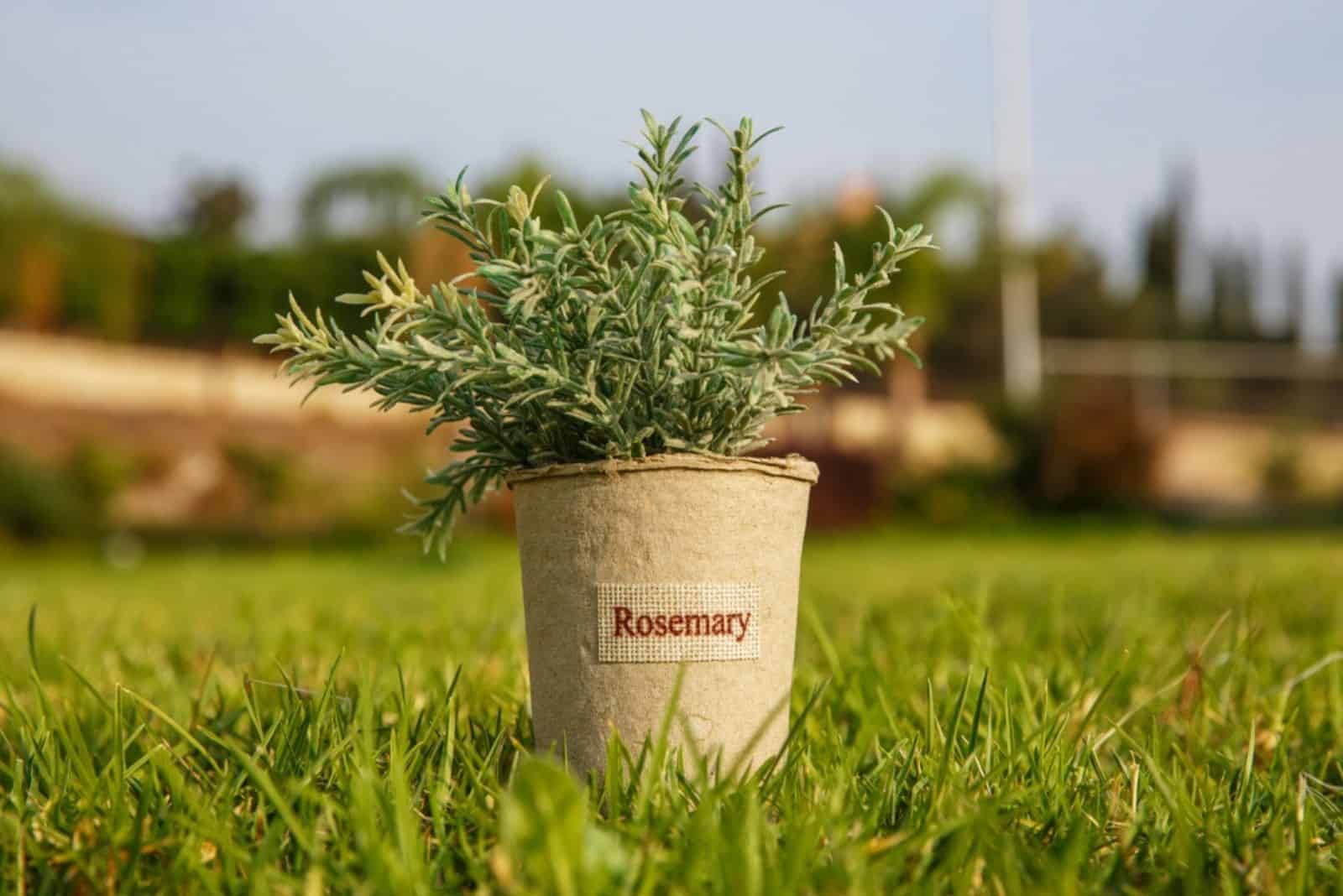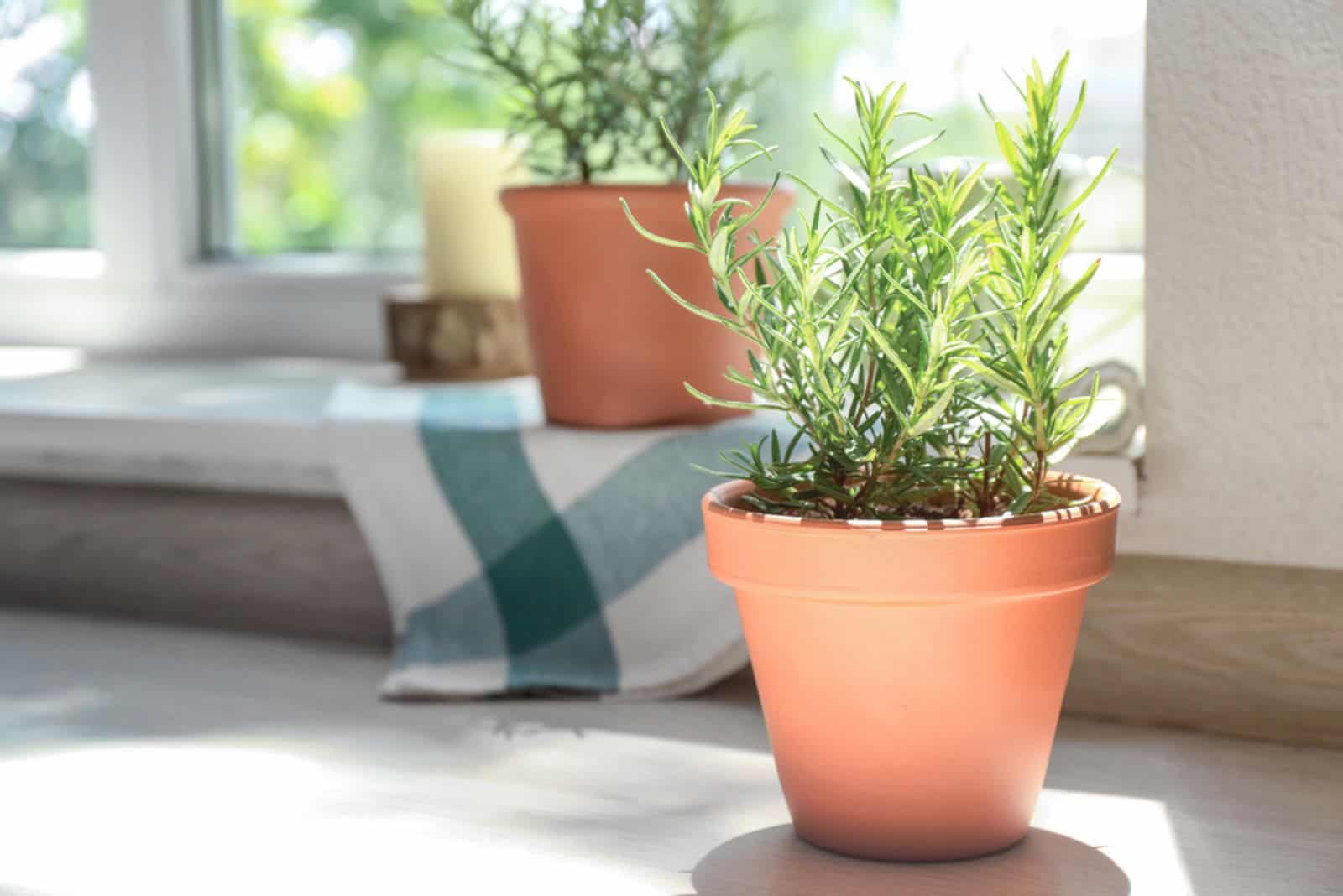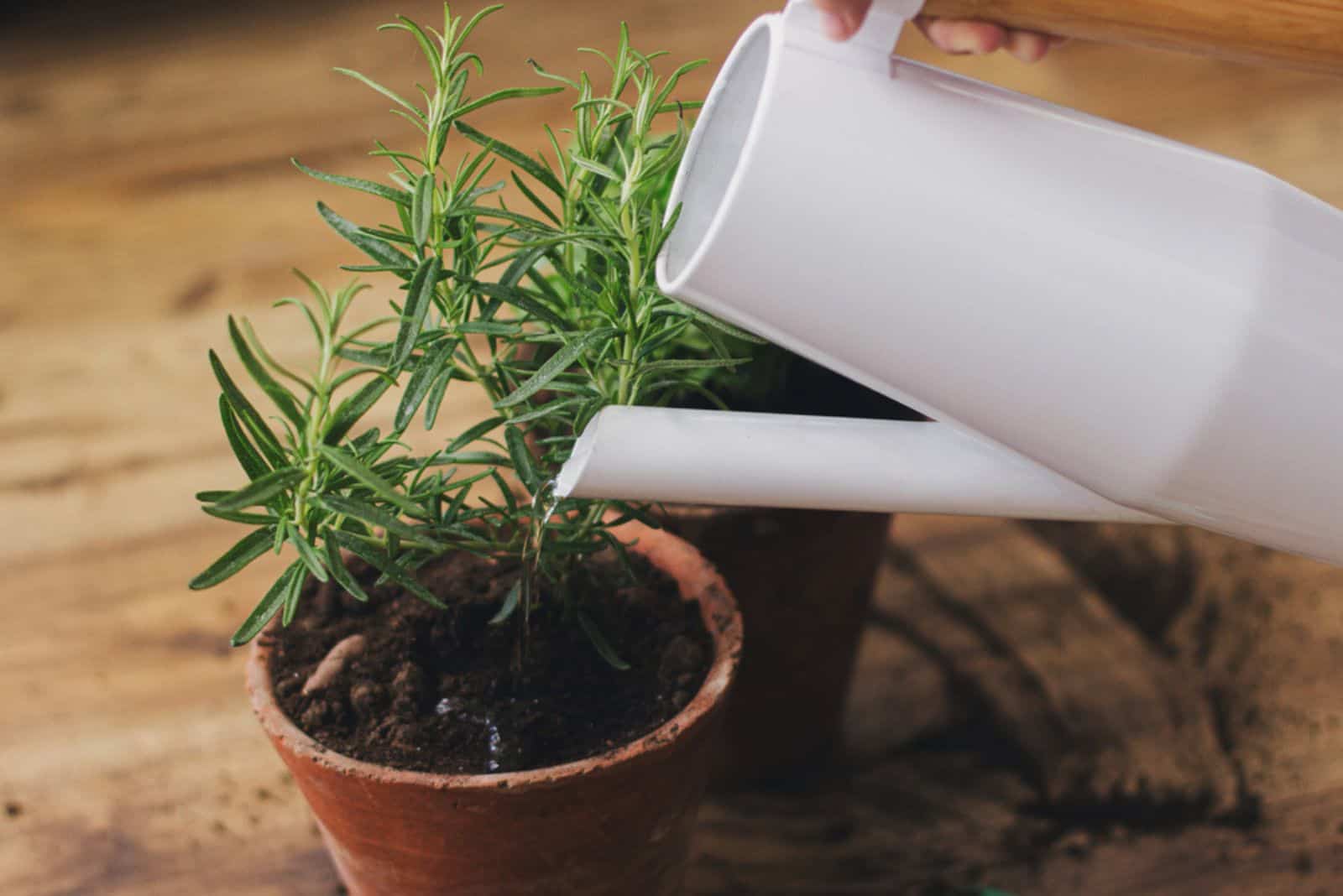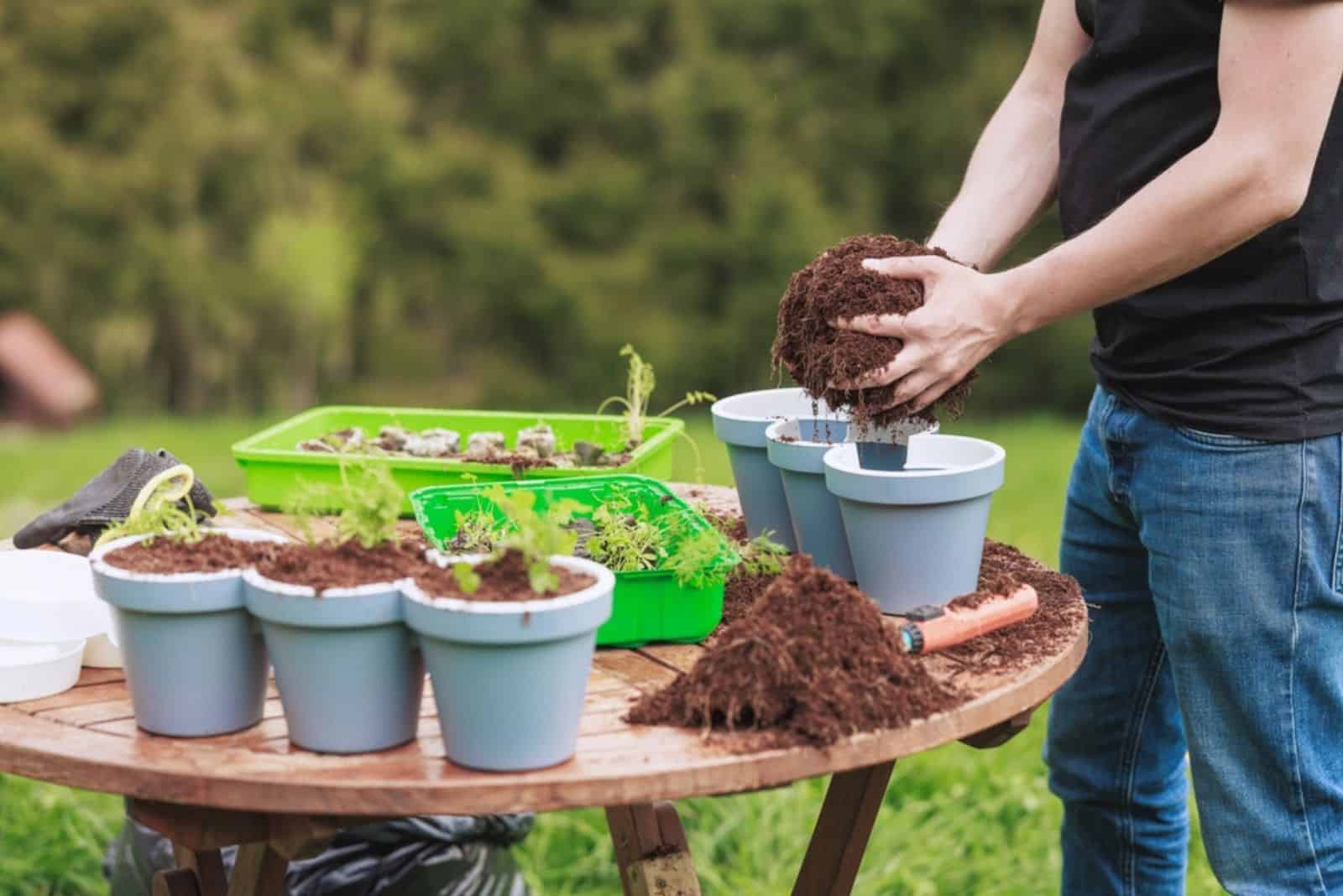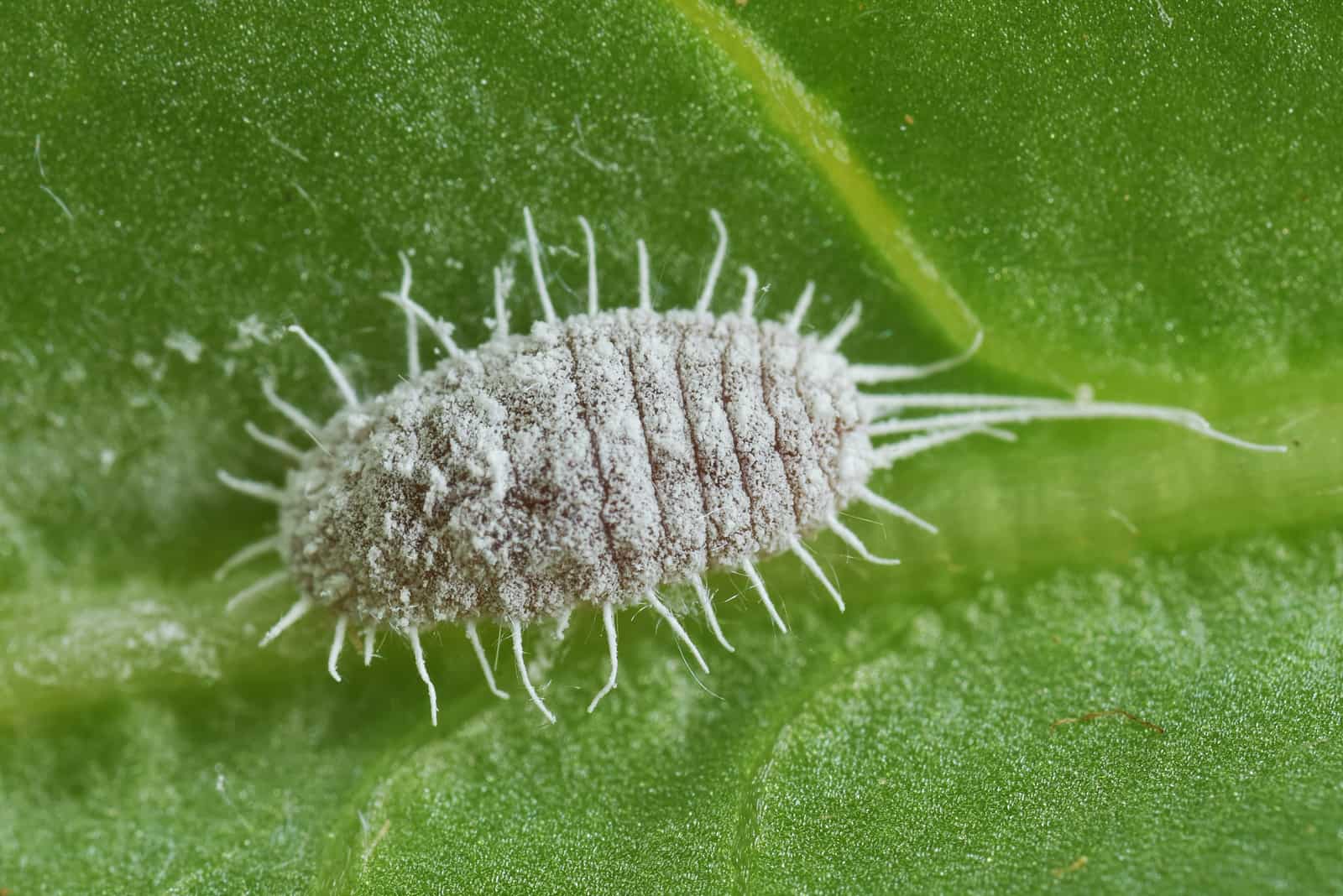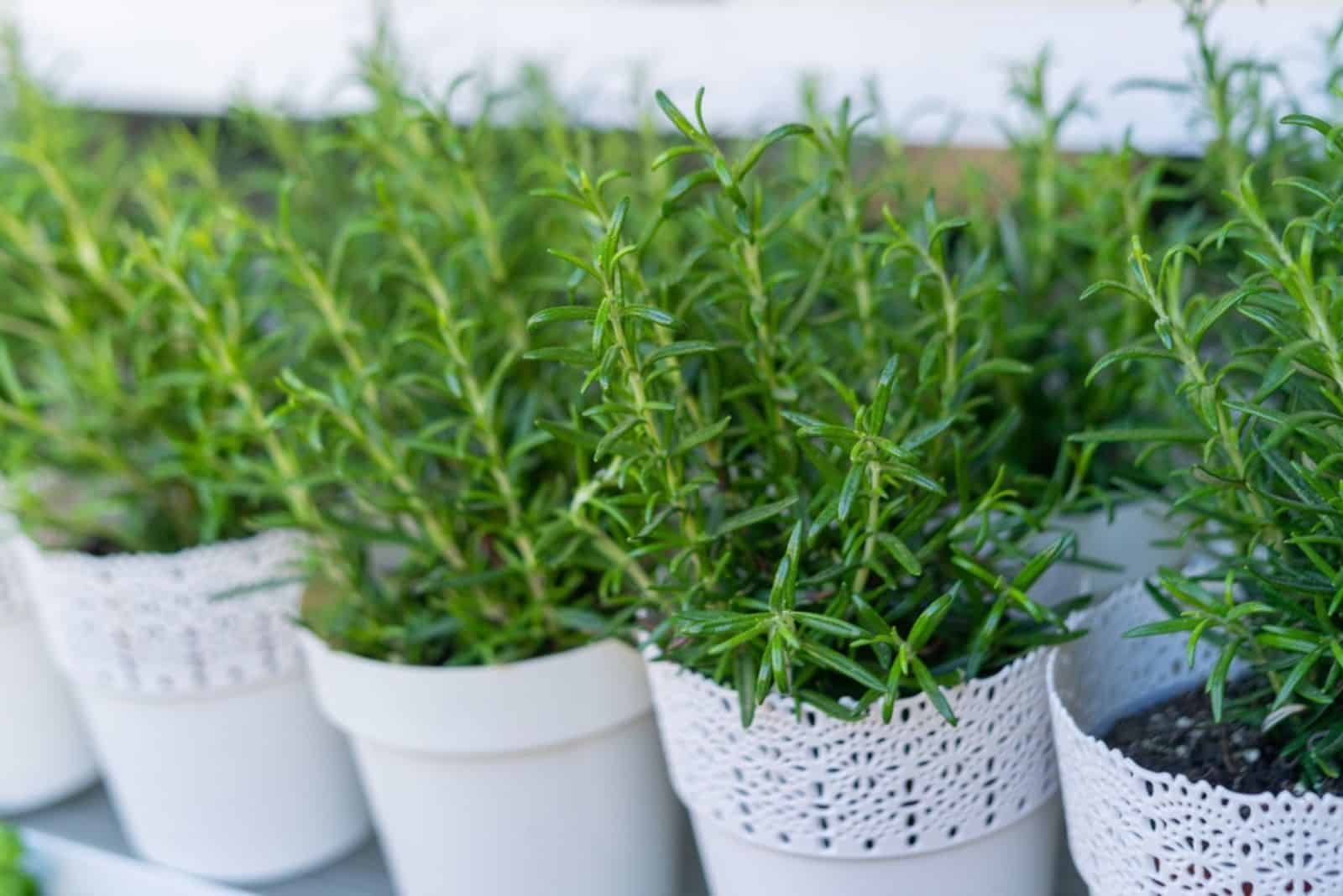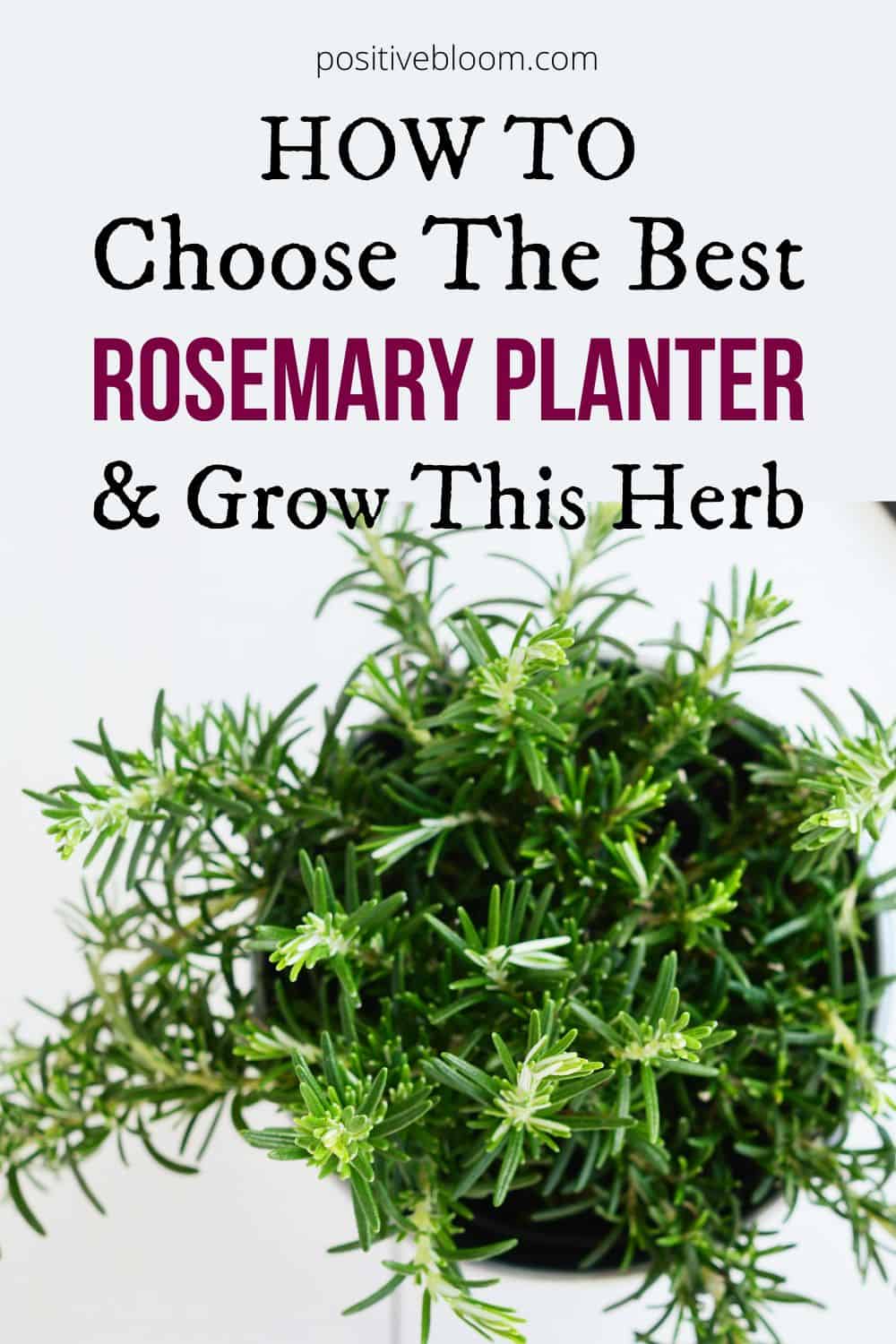Growing rosemary in a pot is a great way to have this culinary herb at hand whenever you’re trying out new fish recipes, seasoning soups, or simply want to add a nice kick to your tuna salad.
Choosing the best rosemary planter and how to grow rosemary in it once you do, are two things that must be explored further by gardeners.
We’ll discuss them both in the following article and also bring you some tips for growing rosemary indoors and outdoors.
Before we get into all that, let’s look into some basic characteristics of this herb:
[table id=442 /]
Choosing A Rosemary Planter For A Herb Garden
Rosemary is on the list of plants with shallow roots, which means it can be successfully grown in a pot.
Before you plant rosemary in your container garden, you should know a few things about choosing a suitable pot, such as picking the right size, material, and drainage.
We’ll discuss these factors below because they can make all the difference between a year-round supply and a stunted herb with only a few needle-like leaves.
Pick The Right Pot Size
The rosemary plant needs a 12-inch pot, even though it doesn’t have an extensive root system.
This herb can get 2-3 feet tall and wide, so if you don’t want its root ball to become all bound and knotted, you should opt for a larger planter.
A 12-inch container will also contain more potting medium and dry out a bit more slowly. However, this is actually a good thing as it can save your herb from dehydrating in the scorching summertime.
The soil can also keep your plant’s roots warm during winter, and if there’s not enough of it, your rosemary might suffer.
Consider The Material
One thing that most growers overlook when choosing pots for their plants is the material. Plastic planters are the most affordable ones, but they aren’t the best choice for kitchen herbs.
Moisture from the potting soil cannot evaporate or drain that quickly, which can make drought-tolerant plants like rosemary very unhappy.
Instead, use terracotta or clay containers as they are more porous and prevent moisture condensation on their walls.
Another benefit of these pots over plastic or metal ones is that they don’t heat up that much, so they won’t hurt your rosemary during hot summer days.
Clay and terracotta planters can also keep your herb plants safe from cold winter and frost.
Don’t Forget The Drainage
The last thing you need to bear in mind when choosing the right rosemary pot is drainage.
The excess water needs to be able to leave the planter because this herb cannot tolerate being water-logged.
Rosemary is susceptible to overwatering and root rot, so pick a container with at least one drainage hole in the bottom.
Growing Rosemary Plant In A Pot
Choosing the right pot is only half the job because you still have to ensure that this herb has proper growing conditions.
Thankfully, there are some great instructions for growing herbs in planters for beginners that also cover rosemary plant care.
Below you will find general guidelines for growing rosemary in planters, from choosing the most suitable variety and the basic requirements to dealing with pest infestations and diseases.
Choose A Suitable Cultivar
There are two primary varieties of rosemary: upright and creeping rosemary. Even though the creeping cultivars look like waterfalls of green leaves sprinkled with foamy blue flowers, they aren’t the preferred choice for culinary use.
However, they are still fragrant and do possess that signature rosemary flavor. One of the most popular creeping rosemary cultivars is ‘Prostratus.’ Its purplish-blue blooms can make your herb garden both attractive and useful.
If you want to use some fresh rosemary in your dishes, the better option would be an upright cultivar – ‘Barbeque’ – because of its intense flavor.
‘Blue boy’ and ‘Arp’ are also popular upright varieties. ‘Arp’ is favored by many growers because its hardiness zones are 6-10, while other cultivars usually grow in zones 8-9.
The key thing when choosing a suitable rosemary variety is to pick one appropriate for your climate so that you don’t have to get new rosemary plants every year.
However, you can also overwinter this herb indoors or grow it inside your home all year round.
Light Requirements
Rosemary is native to the Mediterranean and requires full sun for optimal growth (it needs at least six to eight hours of sunlight each day).
This isn’t an issue when we grow it outside, but it might be more challenging to find a sunny location indoors. The best options would be east or south-facing windows as they can provide plenty of light during the day.
The morning sun is not that harsh, so your rosemary leaves won’t get sunburned.
You can even grow this herb on west-facing windowsills, but the afternoon summer light can be too hot for your plant so you should draw the curtains to filter the sunlight.
If you think your plant won’t get enough light indoors, you can always use some artificial lights for plants. However, don’t place your herb too close to them as they can also burn your plants.
Water And Humidity
Rosemary is a drought-tolerant plant that doesn’t require too much moisture. In fact, if you irrigate it regularly, you will only overwater it and create fruitful ground for root rotting fungi to breed.
Instead, water this herby only when the potting mix has somewhat dried out. You can easily check it by sticking your finger into the growing medium or using a moisture meter.
Technically, you should water rosemary once a week in the summer (or even less frequently, depending on the growing conditions). However, as the temperatures cool down and the growing season ends, you should reduce the watering to every other week.
The best way to irrigate this herb is by soaking it thoroughly and then waiting until the excess moisture drains through the potholes. Empty the tray in half an hour, and that’s it!
Humidity
Unlike some other drought-tolerant plants that love having their roots and foliage nice and dry, rosemary actually prefers higher air moisture levels.
The preferred relative humidity is around 45-55%, so you should increase it a bit if you have decided to raise this plant indoors.
Using a humidifier or occasionally misting the needle-like leaves is more than enough, but you will have to be careful not to “over-humidify” this herb.
Too much moisture on the rosemary leaves can lead to fungal diseases, such as powdery mildew, so you should ensure there’s proper air circulation around your plant.
Not crowding your rosemary or keeping it too close to other plants should do the trick.
Temperature
Rosemary is used to the Mediterranean climate, so you should try to provide it with similar conditions. If you live in a cool region, you can always grow this kitchen herb indoors, but if you live in USDA zones 8-9, you can cultivate it outside all year-round.
This plant cannot tolerate freezing temperatures, and anything below 30°F is potentially deadly.
It can handle temperatures up to 80°F in the summer, but prefers somewhat cooler winter conditions between 60-65°F during the day and around 55°F at nighttime.
You should also avoid keeping rosemary in drafty places, such as near old windows or below AC vents or heaters. This is because temperatures can quickly change and cause stress.
These locations also have lower humidity levels, which is another thing rosemary doesn’t like.
Soil And Fertilizer
One of the main rosemary needs is well-drained soil with neutral or slightly acidic pH. However, this herb can tolerate a wide range of pH levels (5.5-8.0), though this will not give the best results.
It thrives in aerated, loamy mediums that allow the plant’s roots to breathe. The soil shouldn’t be too rich in organic matter because it can retain too much water and lead to root rot.
You can get well-draining and moderately fertile soils on Amazon, but avoid using blends with peat moss or wetting agents. Peat moss changes in the full sun and can lose the ability to hold moisture. In fact, it starts to repel it.
As rosemary requires a lot of sun, the moss wouldn’t absorb water. In return, moisture wouldn’t penetrate the medium, which leaves the herb dehydrated. Wetting agents, on the other hand, can lead to overwatering, so you should avoid commercial soils with these ingredients.
If you don’t feel like sifting through all the ingredients, you can make your own rosemary substrate by mixing equal amounts of horticultural sand with all-purpose compost.
Finally, you can consider using mulch for potted plants as it can preserve more moisture during the hot summer months, keep the roots cool in hot weather and warm in the cold winters, and make it more aesthetically appealing.
Fertilizer
The good news is that rosemary doesn’t require fertilizer if you repot it regularly or change the soil frequently.
However, if you notice that the leaves have become paler than usual or that the plant has slowed down its growth, you can add some balanced fertilizer every other week during the growing season.
Just remember to dilute it so it doesn’t burn the rosemary, and always water the plant either before or immediately after feeding it.
Pruning
There are different techniques for pruning rosemary, and they all include the use of sharp, sterilized tools to prevent the spread of diseases and breaking the stems.
There are three main reasons we prune our plants: to control their size and shape, make them bushier, and remove dead or diseased parts that only take up space and energy.
This herb doesn’t mind being pruned, so it’s not surprising that it’s often used for topiaries to create all sorts of shapes.
Furthermore, if you want to reduce the size of this plant, you should trim 1/3 of the entire plant or cut it back every three months if you wish to own a short rosemary plant.
You can also trim it in order to entice new growth – just prune the outside branches, cutting no more than 1-2 inches. The trimmed branches would split, resulting in a bushier appearance.
Of course, you should regularly prune rosemary to remove all dead or pale flowers and broken or diseased branches.
Here are some more tips for trimming rosemary:
If you hate wasting healthy plant parts, you can always use the cut stems for propagation. Simply remove the bottommost leaves, dip the sprig in rooting hormone, and plant it in a well-draining potting medium.
Repotting Rosemary
It might take some time to notice sprigs of rosemary becoming longer and more numerous, but the roots are a whole different story.
They spread quickly, and your herb can become rootbound and unable to absorb water and nutrients from the soil if you grow it in small pots.
The best thing you can do is plant rosemary in a larger pot, but if you have just gotten a new plant and transplanted it into a container that’s only 1-2 sizes larger, you don’t have to disturb it.
You can repot this plant once a year, choosing a larger pot every time, or you can trim the plant’s roots to prevent it from becoming rootbound.
Terracotta or clay pots with drainage holes provide the best growing conditions for this herb.
It is best to repot rosemary during its growing season (preferably in spring) because that’s when it actively develops and is less likely to go through transplant shock.
Furthermore, transplant this herb as soon as you notice its roots coming out of the drainage holes, the soil drying more quickly, and the bottommost leaves turning yellow.
Finally, always use fresh soil and water the rosemary thoroughly after repotting.
Pests And Diseases
Rosemary is fairly pest resistant due to its strong fragrance that repels cabbage moths, bean beetles, etc.
Some pests, such as aphids and whiteflies, can invade this herb, although that isn’t too common. Indoor plants suffer from pest infestations more frequently, and you should deal with them as soon as you notice a single bug so that they don’t lead to additional issues.
Aphids, for instance, produce a substance that can increase the possibility of mildew, so don’t wait too long to remove them.
You can remove smaller infestations by hand or get some ladybugs to exterminate the pests for you (it is said that a single ladybug can eat 50 aphids per day, so you won’t have to use any pesticides).
Diseases
Even though this herb can deter most pests, the same cannot be said for diseases.
It is easy to overwater this plant and end up seeing the symptoms of root rot, such as stunted growth, discoloration of the foliage, droopiness, etc.
If you notice these symptoms on your rosemary, take it out of its container and check the roots. Soft, soggy, and dark roots are a sign of root rot, and you should cut them off and spray everything with some fungicide just to be on the safe side.
Once you’re done with this, you can return the plant to its container, but make sure to clean it thoroughly to remove any fungal spores, and always use fresh soil for potting.
It is easier to prevent root rot than to deal with it, so plant your rosemary in a pot with drainage holes, use well-drained soil, and water it only when the medium is somewhat dry.
Companion Plants For Rosemary Herb
Companion planting is an excellent option if you don’t have enough space for different herbs, veggies, and flowers. You can also reap the benefits of certain fragrant herbs and repel garden pests in an eco-friendly way.
This handy herb companion planting chart can help you decide which plants you can grow with certain herbs, and when it comes to rosemary, you should raise it with carrots, strawberries, beans, and plants from the cabbage family.
You can also grow it with other herbs with similar needs, such as sage, lavender, marjoram, thyme, oregano, etc.
But what about basil? It goes great with dried rosemary, but can they be grown in the same pot?
Find out below!
Can You Grow Rosemary And Basil Together?
You shouldn’t combine basil and rosemary in the same pot as they have completely different needs.
Basil is a plant that loves fertile and moist growing mediums, while rosemary thrives in poorer and drier soils.
Other herbs that also love moisture are chamomile, chive, and parsley, so you can grow them together with basil.
FAQ
We have covered the most important things about choosing a suitable rosemary planter, as well as the basic needs of this herb.
However, there are still some questions yet to be answered, so we decided to answer the most frequent ones in the section below.
Is rosemary a perennial?
Rosemary is a perennial if you grow it in USDA zones 7 and above. However, you can also cultivate it as an annual to plant a new plant every year.
Of course, if you live in a colder region, growing rosemary in a container is the best option as you can take it indoors once the temperatures cool down and enjoy the scented leaves of the same plant for many years.
This plant has a lifespan of 30 years, so use it to your advantage.
Is coffee good for rosemary plants?
Yes, you can use coffee to feed your rosemary plants, as it contains nitrogen, potassium, and magnesium. Coffee can also make the potting medium more acidic, which is excellent if your current rosemary soil is alkaline.
However, you should always dilute the coffee as it can acidify the soil too much and disrupt the regular uptake of minerals and water.
You can use coffee grounds as a granular fertilizer (just don’t use too much), or you can dilute the brewed coffee with four times as much water.
What are the benefits of rosemary?
Rosemary is rich in manganese, so it can help with blood clotting and with wound healing. Some studies have even shown that it can slow down the growth of cancerous cells due to its carnosic acid content.
It can boost your immune system because it contains rosmarinic and carnosic acids, which are proven to have antiviral, antibacterial, and antifungal effects.
But this herb doesn’t only help with physical health. Rosemary can help with concentration and memory, and also reduce stress, so add a couple of sprigs to your next meal.
Wrapping Up
This article presented some tips for choosing the best rosemary planter and tricks for growing this herb in pots.
Rosemary is a perennial that lives a long life if you care for it properly, and growing it in a planter where you can control the moisture and sun exposure greatly helps.
This is a Mediterranean herb, so it cannot tolerate freezing temperatures. But that’s another perk of planting it in a container – you can always move the pot to a warmer and more secure location.
The only thing you need to look out for (aside from light exposure) is proper drainage, so make sure to plant your rosemary in well-drained soil and clay or terracotta pots (which are more porous) with drainage holes.
Caring for rosemary isn’t that difficult, and you can always pair it with some other drought-tolerant herbs such as lavender, sage, thyme, etc.
If you want to use its pest-repelling properties, you can always place the rosemary planter near your vegetable garden or certain plants such as carrots, strawberries, beans, etc.
Until next time!
Like this post? Share or save it for later!

